Ye Be Judged—And Ye Be Canceled
By now, it’s become obvious that every historical personage can be judged and found wanting–and thus must be, to apply the voguish phrase, “canceled.” To the well informed, the fact that all people are flawed is not a revelation; after all, just about every intellectual and theological system in human history has been built around the premise that everyone has failings.
For instance, the historically-minded have always understood that men and women are by definition products of the time in which they live—and so they can only be fairly judged in the context of their era. To judge them by some standard created after their death is by definition to judge them unfairly—because we can never know how they would have acted if they had known what we know.
Or as the famed writer Louis L’Amour–who put so much historical learning and human insight into his novels—explained, “A mistake constantly made by those who should know better is to judge people of the past by our standards rather than their own. The only way men or women can be judged is against the canvas of their own time.”
In the meantime, the religiously-minded understand that men and women may be sinners, and yet most faith systems include some vision of betterment, even redemption. For instance, Christians believe Jesus Christ when He says, “I am the way and the truth and the life.” And so if they follow Him, they believe, they will be forgiven and redeemed.
These days, the current belief of Wokeness—the zealous thinking animating many of the protestors and statue-destroyers—seems a lot like a new religion. That is, Wokeness has its own version of sacred words, shrines, and saints; for instance, at the funeral of George Floyd, the deceased was depicted as an angel, complete with wings and halo, and murals of him in a saintly or heavenly pose have sprung up all around the world.

Joshua Broussard kneels in front of a memorial and mural that honors George Floyd in Houston’s Third Ward where Floyd grew up on June 8, 2020 in Houston, Texas. (Joe Raedle/Getty Images)
Yet these appearances notwithstanding, most Wokesters say that they reject Christianity. In fact, one of the Woken, Shaun King, a journalist-activist currently employed at Harvard Law School—when he isn’t raising money for his many causes—tweeted recently, “I think the statues of the white European they claim is Jesus should also come down. They are a form of white supremacy.” Lest King be misunderstood, he added, “All murals and stained glass windows of white Jesus, and his European mother, and their white friends should also come down. They are a gross form [of] white supremacy. Created as tools of oppression. Racist propaganda. They should all come down.”
We can add that there’s a whole Old Testament, too. So maybe we’d better get rid of that, as well. And what of Adam and Eve? Should we at least be done with Adam?
Indeed, Timothy Dolan, the Catholic archbishop of New York, conceded on June 29, “The Bible is full of flawed characters.” Of course, Dolan loves the Bible, flawed people and all; in fact, he thinks we should learn from it, declaring “If literature that depicts prejudice, or words or scenes that are today rightly abhorred, is to be banned, I don’t know if even the Bible can survive. If we only honor perfect, saintly people of the past, I guess I’m left with only the cross.” And then Dolan snapped, “And some people would ban that.”
These days, the politically correct term for “banned,” of course, is “canceled.” As in, The Bible should be canceled.
Yet some close observers believe that even if the new Wokism despises Christianity and other traditional faiths, it still owes faith a debt. As the British author Antonia Senior puts it, Wokeness is a “secular religion,” deriving much in particular from the form, if not the actual faith, of Christianity.
Yet what’s remarkable about Wokeness, Senior continues, is the absence of any system of forgiveness, at least for white people; it is, she declares, “Christianity without redemption.”
That is, if whites are regarded as intrinsically wicked—because they are either overtly racist or, just as bad, in denial about their racism—then the only hope for them is to become, in the words of millionaire “anti-racism” crusader Robin DiAngelo, “less white.” (DiAngelo herself is white.)
In fact, a prescient take on this emerging belief system appeared nearly two years ago during the Senate hearings on Brett Kavanaugh’s nomination to the Supreme Court. Conservative think-tankers Bruce Abramson and Jeff Ballabon wrote about the dogmas of “cancel culture.” As they argued:
It is not mere cynicism. It is not mere politics. It is an entirely illiberal replacement morality. It is an intentional rejection of human rights, personal responsibility, and the inalienable rights to life, liberty, and the pursuit of happiness. It is something very new—and it is, by every standard of Western civilization, profoundly evil. It also is terrifying: a brutal caste system that inflicts punishment based on gender, race, religion, nationality, ethnicity, and orientation; a venting of rage, without regard to impact on individuals or civilization.
In the face of such angry totality, it’s not surprising that history itself is now subject to cancellation.
History Disappears Down the Memory Hole
In George Orwell’s novel 1984, one of the techniques of totalitarianism is the “memory hole.” That’s the place where inconvenient facts go to die—or so Big Brother hopes.
These days, Big Brother, Big Sister, and Big They have launched their campaign against just about everything; one is reminded of the Red Guards of Maoist China, campaigning against the “Four Olds”: Old Customs, Old Culture, Old Habits, and Old Ideas.

A poster is displayed on a Beijing street in 1966 showing how to deal with so-called “enemy of the people” during the Great Proletarian Cultural Revolution in Maoist China.
Here in the U.S., one new target is an old leader, Woodrow Wilson, 28th president of the United States; Princeton University just struck his name from its renowned school of international affairs.
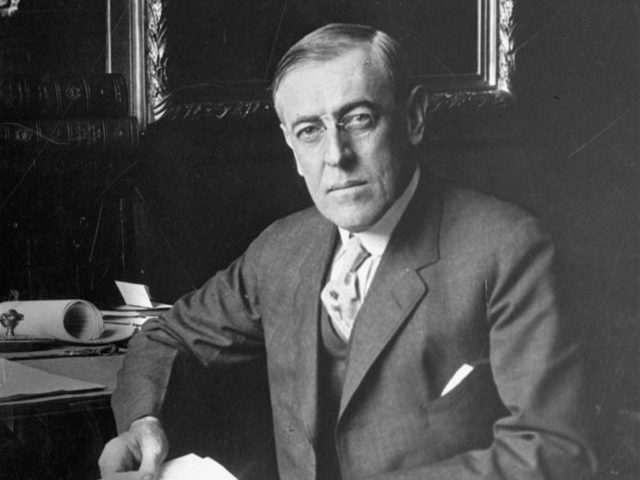
Woodrow Wilson, the 28th U.S. President (AP Photo)
Wilson graduated from Princeton in 1879, and later taught there as a professor, before rising to the presidency of the school and then being elected president of the United States in 1912. And while Wilson certainly had his failings, he must have done something right; he was, after all, re-elected in 1916.
Indeed, most rankings of American presidents over the last few decades have included Wilson in the top ten of our chief executives. No wonder dozens of places and institutions are named in his honor, including the Woodrow Wilson Bridge across the Potomac River, and the Woodrow Wilson International Center for Scholars, a part of the Smithsonian Institution. What will happen to all these Wilsons? Stay tuned.
We might also add that a goodly number of places and things in Europe are named after Wilson; having been the architect of American victory in World War One, Wilson’s “Fourteen Points” of diplomacy, outlined in 1918, were a clarion call for “national self-determination”—that is, a proper nationalism for each nation.
Yet if Wilson goes, it’s quite likely that not a single U.S. president—with the presumed exception of Barack Obama—isn’t vulnerable to being memory-holed. In fact, just on June 28, New York Times columnist Charles Blow headlined his column: “Yes, Even George Washington.” Lest he be misunderstood, Blow laid it out: Cancel our first president? “Abso-fricking-lutely!” (Perhaps not so coincidentally, as Breitbart News reported, two statues of George Washington in New York City were soon vandalized.)
Of course, if the presidents go, there’ll be no stopping the Woke crusaders. As Sean Davis of The Federalist tweeted:
New York City, which was colonized by slave traders, is named after James Duke of York, who founded and ran a slave-trading monopoly that shipped more African slaves to the Americas than any other institution in the history of the Atlantic slave trade. #CancelNewYork.
Sen. Ted Cruz then added, “Clearly The New York Times must be renamed.”
Speaking of place-names, there’s the matter of this hemisphere, which is named after the Italian navigator Amerigo Vespucci. Indeed, in the minds of Wokesters, he’s trebly problematic, because he was white, a colonialist, and a Christian. As he wrote of his trip to Brazil in the early 16th century, “We dropped our anchor off the shores of that new land, thanking God with solemn prayers and the celebration of the Mass.”
And speaking of Catholics, we might also take note of the latest outbursts of anti-Catholic deviltry: the campaign against Catholic saints. Yes, you read that right. In St. Louis, protestors have defaced and attempted to destroy the statue honoring the French saint who gave that city its name. The wild ones were thwarted, in part, by a brave Catholic priest, Fr. Stephen Schumacher, who, crucifix in hand, faced them down. When he was ordained just last year, Fr. Schumacher knew that he would be living a challenging life as a priest, and yet he probably never imagined that in his first year as a priest he would be risking martyrdom in defense of his faith–and in defense of the religious freedom of all of us, Catholic or not.
There’s more: On July 11 in California, a fire engulfed the 249-year-old San Gabriel Mission near Los Angeles. “My heart is full of sadness,” said parishioner Anita Chavez, as she stood watch in vigil over her torched church. The source of the fire has not yet been determined; but the mission’s founder, Fr. Junipero Serra, is a major target of the Wokesters who have been busy toppling his statues and hoping to cancel his memory. Fr. Serra has long been a folk hero in California–he was the builder of many mission houses to protect the poor, from San Diego to San Francisco–and was canonized as a saint by the Roman Catholic Church in 2015.
Yet Serra, the Wokesters now say, was in fact a Spanish imperialist, mistreating Native Americans. Actually, that’s not true; the truth is just the opposite. As one expert explains:
There’s no single recorded example in the official documentation of the period that Serra mistreated the Native Americans … in fact, he walked all the way to Mexico City to get a bill of rights issued for them. He was a great man all around.
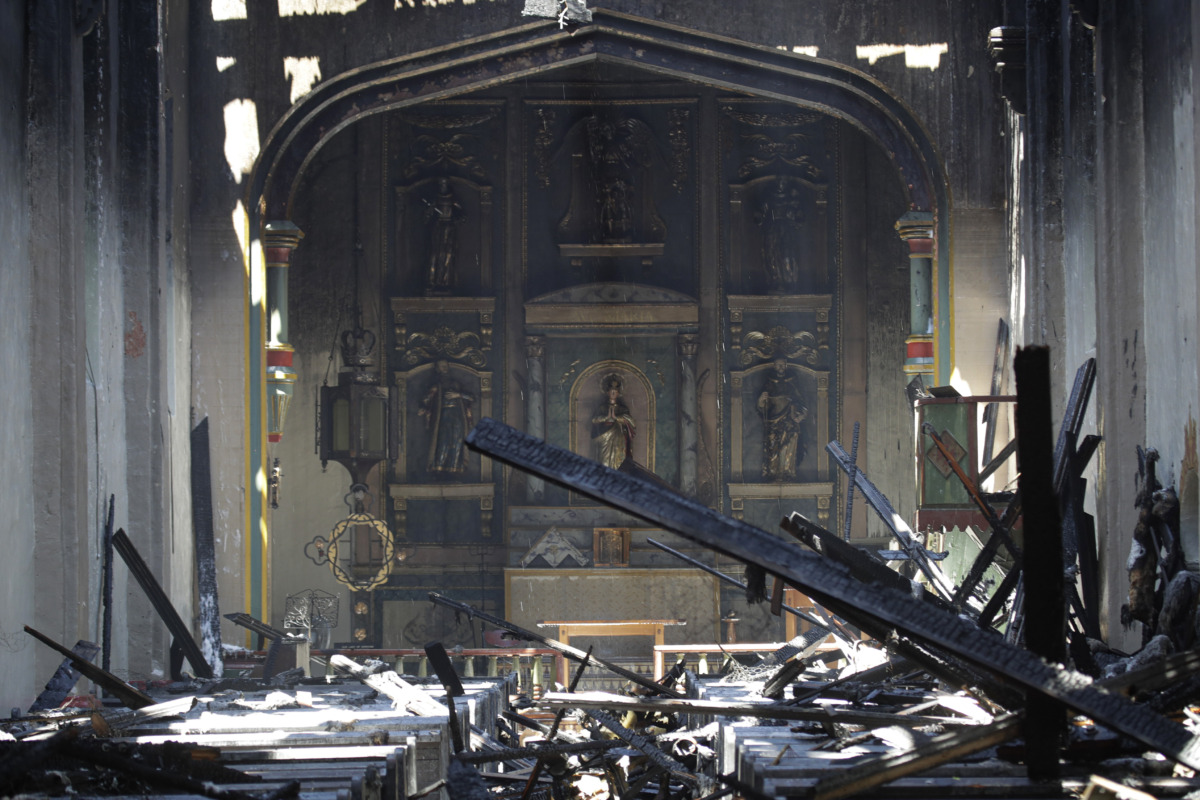
The interior of the San Gabriel Mission is seen in the aftermath of a morning fire, Saturday, July 11, 2020, in San Gabriel, CA. The fire destroyed the rooftop and most of the interior of the 249-year-old church that was undergoing renovation. (AP Photo/Marcio Jose Sanchez)
Of course, most of these earthly devils don’t really care about the facts–they just want to destroy and enjoy. And so they must have enjoyed, too, wrecking statues of the Virgin Mary in Boston.
Even now, some might think that’s not quite possible in America; they should know that it is possible. How do we know? Because it’s happened before.
To Hell with History: Year One
In 1789, the French Revolution erupted against the royal government of King Louis XVI. For a time, it seemed as though moderates would lead, and the result would be some sort of peaceable arrangement, with, say, Louis reigning as a constitutional monarch, a figurehead.
Yet soon enough, revolutionary radicals, known as Jacobins, seized control, and the result was the Reign of Terror, in which perhaps 300,000 French citizens were arrested (more than one percent of the population, then 28 million). Of those arrested, some 17,000 were executed, and another 10,000 died in prison. Those executed, of course, included Louis and his wife Marie Antonette. In addition, their son, Louis Charles, died in prison at the age of 10.
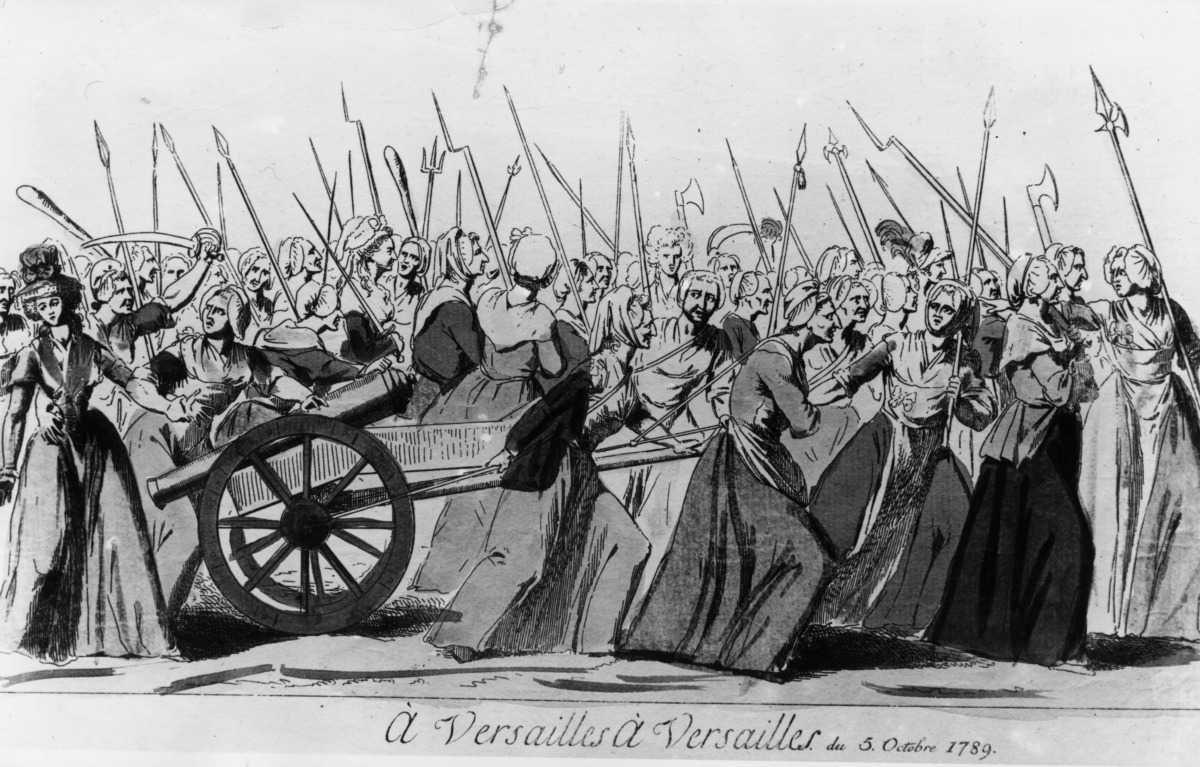
5th October 1789: A mob armed with spears, pikes, and a cannon set off to attack the royal palace at Versailles in the early stages of the French Revolution. (Rischgitz/Getty Images)
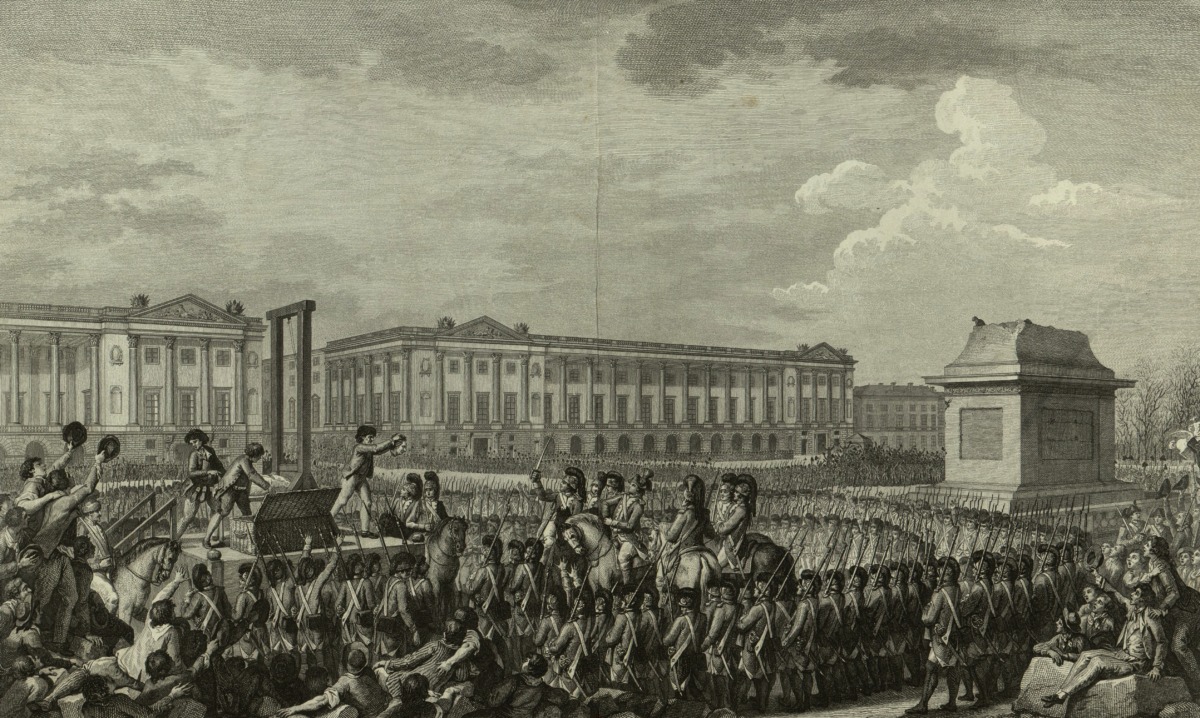
Execution of Louis XVI on 21 January 1793, in what is now the Place de la Concorde, facing the empty pedestal where the statue of his grandfather, Louis XV, had stood. (Wikimedia Commons)
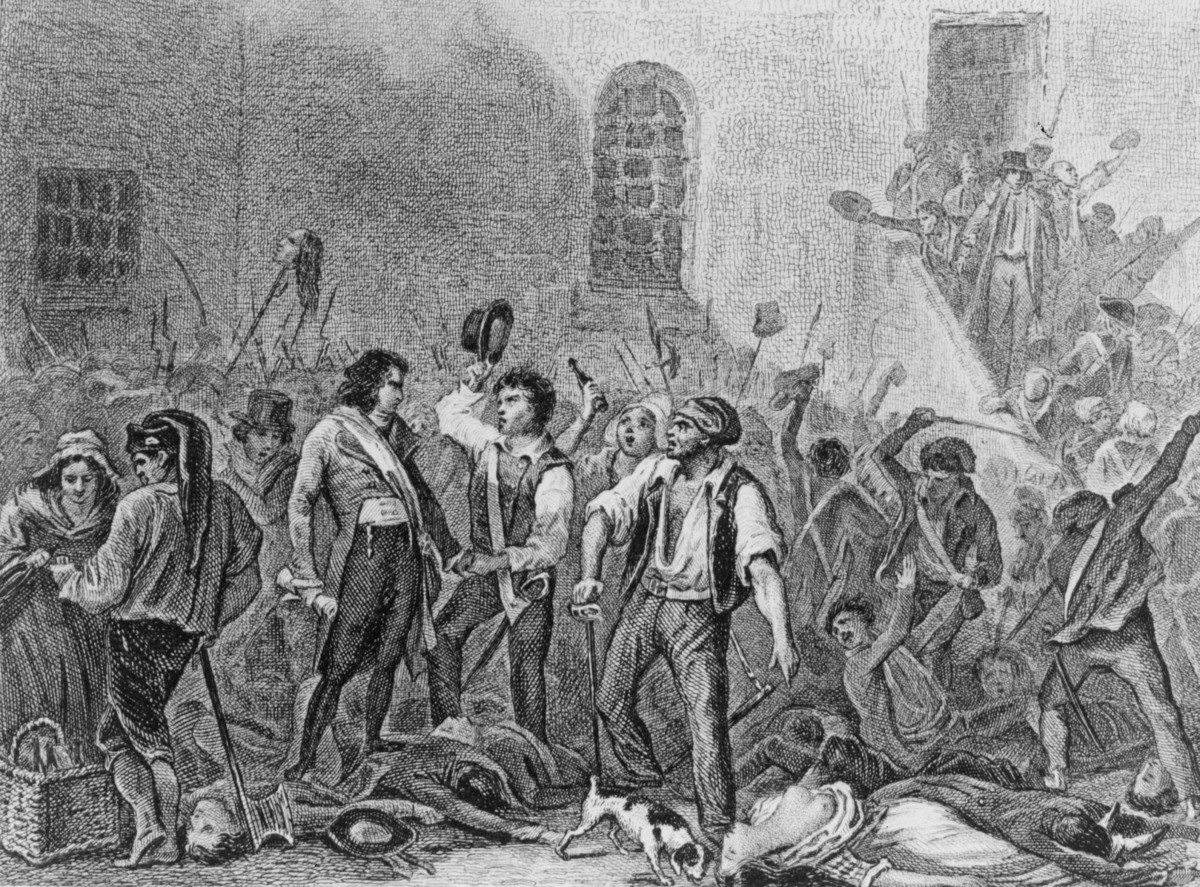
A massacre of aristocrats at a prison in Paris during the French Revolution. (Hulton Archive/Getty Images)
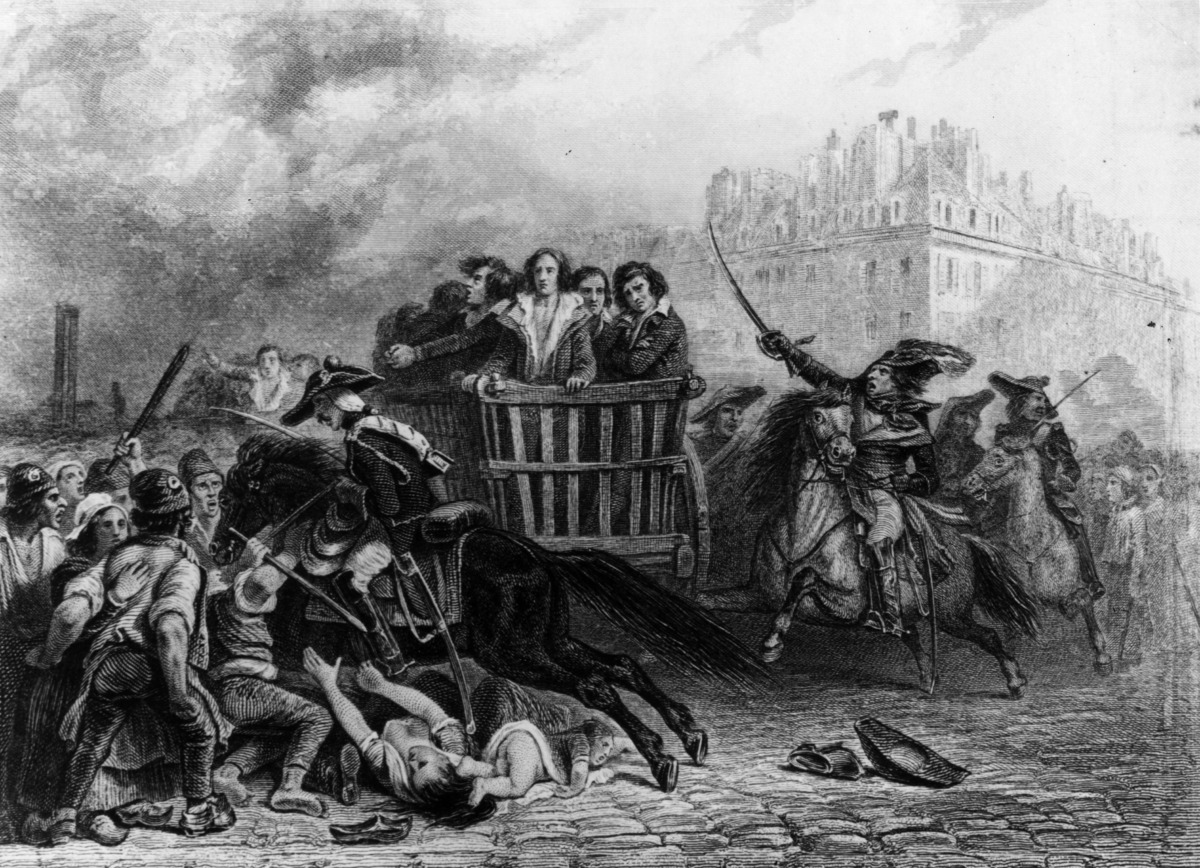
Circa 1790s: Crowds being held in control as a tumbril takes prisoners to be executed in the French revolution. (Hulton Archive/Getty Images)
In such an atmosphere of bloody head-chopping, the radicals figured, Why not chop history, too? Why not get rid of the calendar itself?
And so that’s what they did. In 1793, the revolutionary government formally declared that 1792 should be re-designated as “Year I,” with 1793 as “Year II,” and so on. (Interestingly, the French chose to render their new years in Roman numerals; evidently, they didn’t deem the slave-holding Romans to be politically incorrect, in need of cancellation.)
Now we might note that this system was so crazy as to be unworkable. That is, even the revolutionaries had trouble reconciling the new numbering system with documents, contracts, and so on. Thus after a while, when revolutionary ardor cooled, the “Republican calendar” was scrapped. It lasted until Year XIV, when the familiar Gregorian calendar was restored, and Year XIV became what it had always been: 1806. The fantasy—the flight from reality—had come to an end.
Yet interestingly, the same fantasy idea re-emerged in the next century. In 1975, the Cambodian Khmer Rouge—Cambodia having once been a French colony—seized power and tried the same revolutionary re-numbering. Thus 1975 was designated as “Year Zero.” Tragically, the Khmer Rouge were vastly more bloodthirsty than than the Jacobins; it’s estimated that in the next four years, the regime killed between 1.5 and 2 million people–or somewhere around a quarter of the population.
So we can see: When crazies get going, there’s no telling where they’ll go.

April 17, 1975: The Khmer Rouge guerrilla soldiers wearing black uniforms drive atop jeeps through a street of Phnom Penh, the day Cambodia fell under the control of the Communist Khmer Rouge forces. (SJOBERG/AFP via Getty Images)
Thus the American people—the normal American people, regular folks in both parties—are going to have to stand up. Stand up, that is, for their public monuments, their history, and quite possibly for their very lives. Yes, the stakes are that high.
A New Hope
Still, there’s some reason for optimism in the face of this onslaught. After all, the American people as a whole are hardly on board for this craziness. Indeed, even many on the left are now waking up to threat of this Awokening. In fact, just on July 7, a group of 153 prominent writers, artists, and public intellectuals—including J.K. Rowling, Salman Rushdie, Margaret Atwood, Wynton Marsalis, and Noam Chomsky—signed on open letter in Harper’s Magazine in which they declared themselves to be firmly opposed to this incipient PC totalitarianism.
As they put it, “The free exchange of information and ideas, the lifeblood of a liberal society, is daily becoming more constricted, an intolerance of opposing views, a vogue for public shaming and ostracism and the tendency to dissolve complex policy issues in a blinding moral certainty.” Their letter concluded:
This stifling atmosphere will ultimately harm the most vital causes of our time. The restriction of debate, whether by a repressive government or an intolerant society, invariably hurts those who lack power and makes everyone less capable of democratic participation. The way to defeat bad ideas is by exposure, argument, and persuasion, not by trying to silence or wish them away. We refuse any false choice between justice and freedom, which cannot exist without each other. As writers we need a culture that leaves us room for experimentation, risk taking, and even mistakes. We need to preserve the possibility of good-faith disagreement without dire professional consequences. If we won’t defend the very thing on which our work depends, we shouldn’t expect the public or the state to defend it for us.
We might observe that all this is the standard language of free speech and free thinking, and it’s entirely, of course, on the mark. Indeed, it’s the sort of pro-First Amendment argumentation that one would expect in any constitutional-law classroom—or, at least, one would have expected it, before so many law professors and students went Woke.
And because of the new power of Wokeness, the blowback to the letter was immediate; in fact, under pressure, some of the signatories have already retracted their support.
So now we’ll have to see which side prevails: First Amendment advocates or the Woken.

COMMENTS
Please let us know if you're having issues with commenting.